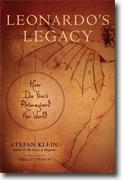Leonardo's Legacy
Stefan Klein
book reviews:
· general fiction
· chick lit/romance
· sci-fi/fantasy
· graphic novels
· nonfiction
· audio books
· author interviews
· children's books @
curledupkids.com
· DVD reviews @
curledupdvd.com
newsletter
win books
buy online
links
home
for authors
& publishers
for reviewers

 |
Leonardo's Legacy: How Da Vinci Reimagined the World Stefan Klein Da Capo Press Hardcover 304 pages April 2010 |
|
Leonardo da Vinci saw the world afresh, from different perspectives than most of us do. He influenced several different fields, ranging from art to science to warfare and everything in-between. Stefan Klein’s intriguing and highly interesting book Leonardo's Legacy
Another theory is that it is a painting of the renowned courtesan Isabella Gualinda: “When a rich patron commissioned a portrait of this woman, the story goes, Leonardo simply recycled the unfinished portrait of Lisa Gheradini.”Still another theory claims that the Mona Lisa is, in reality, a self-portrait. If Leonardo’s face is flipped in a self-portrait of himself as an older man, his features match almost exactly with those of the Mona Lisa. Critics of this theory, though, say that is only because it was Da Vinci’s style to be exact in elements of his art, like how far apart he would space the eyes of his subjects. There’s a wealth of information in Klein’s book, some of which I’d never read about before - like da Vinci having invented a mechanical lion that could walk a few steps, rise up on its hind legs, and open its chest cavity. Da Viinci demonstrated it for the French king at a banquet. Much to the delight of the king, who became Leonardo’s patron and friend in his later years, da Vinci had rigged the lion so that when its chest cavity opened, it presented the king with “a bouquet of lilies, the coat of arms of the French royal family.” Leonardo wrote and drew diagrams about “the three crescent-shaped pockets of the aortic valve.” He figured out how the valve opened and closed and let blood flow - a particularly amazing feat given that it was not until 1999 that “researchers in London, Boston, and California, using magnetic resonance velocity mapping, were finally able to obtain images of blood flow in the living heart. They found exactly what Leonardo had described.” . He figured out the workings of the human heart in a most ingenious way: by making a heart out of glass, then pouring “wax into the valve of a bull’s heart so that you may see the true shape of this valve.” He then traced the flow patterns that blood would make “by adding particles to the fluid.” (He used millet seeds.) Leonardo’s life and legacy were truly extraordinary. Thankfully, due to efforts to collect his extant notebooks and to decode and translate his writing, we are getting a clearer picture than ever before of his many insights and inventions, and the reasons why hundreds of years after his death that his fame continues to grow. Art lovers who want to learn more about one of the greatest artists and intellectual minds of all time should add Leonardo's Legacy Originally published on Curled Up With A Good Book at www.curledup.com. © Douglas R. Cobb, 2010 |
|
|
|
 Click here to learn more about this month's sponsor! |
|
| fiction · sf/f · comic books · nonfiction · audio newsletter · free book contest · buy books online review index · links · · authors & publishers reviewers |
|
| site by ELBO Computing Resources, Inc. | |
 In the first chapter, “The Gaze,” Klein analyzes the mysterious gaze of the woman in Leonardo’s most famous painting, the Mona Lisa. He also delves into the numerous theories about exactly who Da Vinci was portraying, and why he took it along with him wherever he traveled for the last ten years or so of his life. Many theories abound as to who the subject actually is; I believe the person most likely is Lisa Gherardini, sometimes known as Lisa Giaconda, a Florentine woman who was the wife of “a silk merchant named Francesco del Giocanda.
In the first chapter, “The Gaze,” Klein analyzes the mysterious gaze of the woman in Leonardo’s most famous painting, the Mona Lisa. He also delves into the numerous theories about exactly who Da Vinci was portraying, and why he took it along with him wherever he traveled for the last ten years or so of his life. Many theories abound as to who the subject actually is; I believe the person most likely is Lisa Gherardini, sometimes known as Lisa Giaconda, a Florentine woman who was the wife of “a silk merchant named Francesco del Giocanda.